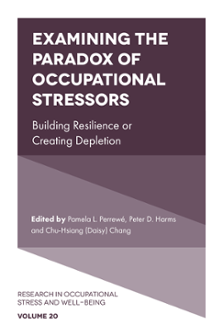
Index
Examining the Paradox of Occupational Stressors: Building Resilience or Creating Depletion
ISBN: 978-1-80455-086-1, eISBN: 978-1-80455-085-4
ISSN: 1479-3555
Publication date: 10 October 2022
Citation
(2022), "Index", Perrewé, P.L., Harms, P.D. and Chang, C.-H.(D). (Ed.) Examining the Paradox of Occupational Stressors: Building Resilience or Creating Depletion (Research in Occupational Stress and Well Being, Vol. 20), Emerald Publishing Limited, Leeds, pp. 171-174. https://doi.org/10.1108/S1479-355520220000020002
Publisher
:Emerald Publishing Limited
Copyright © 2022 Pamela L. Perrewé, Peter D. Harms and Chu-Hsiang (Daisy) Chang
INDEX
- Prelims
- Chapter 1: Becoming Comfortable with the Uncomfortable: The Paradoxical Role of Learning in the Coping Process
- Chapter 2: What is Resilience? Offering Construct Clarity to Address “Quicksand” and “Shadow Side” Resilience Concerns
- Chapter 3: Walking the Tightrope: How and When the Paradoxical Act of Breaking Character Leads to Resilience
- Chapter 4: My Work is Who I Am, But it’s Killing Me: An Identity-based Approach to the Paradox of Passion
- Chapter 5: The Role of Positive Psychological Variables in the Cognitive Appraisal of Job Insecurity: A Latent Class Approach
- Chapter 6: The Paradox of Neuroticism and Vigilance Work
- Chapter 7: Paradoxical Relationships of Workplace Mistreatment
- Index